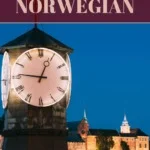Being able to ask for the time or respond to the question is an important early step in learning Norwegian.
Telling the time is easy right? Well if you’re a native English speaker learning Norwegian, not so much. But worry not! We’ve prepared this little summary for you.

When you see English in parentheses, it’s a literal word-for-word translation, to give you an idea of how odd telling time works in Norwegian.
How much is the clock?
If someone asked you how much “the clock” is, in English, you’d be forgiven to give them an amount for what you think the nearest clock is worth. Or for telling them it’s not for sale, thank you.
If the person asking the question is Norwegian though, it’s likely that they’re just translating directly from the Norwegian “Hvor mye er klokka?” (How much is the clock?), which really means “What time is it?”.
Use the 24-hour clock in Norway
Like most European countries, Norway uses the 24-hour clock. Therefore, the English 3pm becomes 1500 in Norwegian. This doesn’t read as “fifteen hundred hours” like in the American military, but as “femten null null” (fifteen zero zero).
Read more: The Numbers in Norwegian
Alternatively, you can say “klokka femten” (fifteen o’clock). That being said, it’s quite common to say “klokka tre” (three o’clock) when meaning 3 in the afternoon, if the context makes it clear that that’s what you mean.

When writing down the time in Norwegian though, always use the 24-hour clock – like this: “kl.15” for 3pm.
Norwegian grocery stores are an example of this consistent use of the 24-hour clock in written form. They conveniently write their opening hours in big letters on the side of the building.
So, 7-23 (8-22) means the store is open from 7am to 11pm on weekdays, and 8am to 10pm on Saturdays.
Quarter past, quarter to…
Fifteen minutes in Norwegian is “femten minutter”, but it’s also very common to say “et kvarter” (a quarter).
If the time is 07:15, you can say “kvart over sju” (quarter over seven). If it’s 07:45, you can say that it’s “kvart på åtte” (quarter to eight). So far so good, right?

Half past…
This is where things start getting weird. So by now you know 3pm can be either “klokka 15” or “klokka 3” when there’s enough context. But what’s half past three? Well… it’s “halv fire” (half four).
If you’re American, that’s puzzling enough, but if you’re British, it’s extremely counterintuitive (since “half four” means “half past four” in British English). So 15:30 is “halv fire” (half four), 08:30 is “half ni” (half nine) and 21:30 is “halv ti” (half ten).
As if that was not confusing enough, the “halv” rule doesn’t apply to all times greater than 12. You can say “halv elleve” for 10:30 and “halv tolv” for 11:30, but not “halv tretten” for 12:30. Why, you ask? If you ever find out, you really have to tell me.
Read more: The Norwegian Alphabet
Perhaps it has to do with the fact that the 24-hour clock, past 12, will be used in more formal speech. People will then say “femten tretti” (fifteen thirty). Colloquially, people will say “halv fire på ettermiddagen” (half four on afternoon).
Let’s complicate things even more
If you think “half four” for 15:30 is weird, wait until you hear this: 15:20 is “ti på halv fire” (ten to half four).

In other words, when telling the time, Norwegians start referring to the next hour already at twenty minutes past the previous hour. It's the same situation at 15:25: “fem på halv fire” (five to half four). It’s 15:40? “Ti over halv fire” (ten over half four).
It's enough to make you want to wait an extra five minutes before telling the time, since at 15:45 the madness finally ends with a rather normal “kvart på fire” (quarter to four).
Is there a German in the room?
If you’re German and reading this, none of what I said came as a surprise. Germans tell the time in much the same way as Norwegians.
In fact, in Norwegian class, German students are often rather good because they get so much for “free” (lots of vocabulary has common roots in both languages).
So there you have it. If a Norwegian ever tells you the time is five over half two, you’ll know exactly what they mean… right?



Thank you so much for your article. I’m trying to learn Norwegian on Duolingo but I truly thought I was completely stupid when it came to telling the time – especially the half hours! I could see what was happening but had no idea why. It’s all really clear to me now 😳😂
Glad I could help ☺️
I am Norwegian and see nothing wrong with how we tell time. So when my family goes to Norway I have to tell them. My friend was going to the US ant told the people to pick her up at 13:30 they neve showed up.
Just to add…. when I learnt Norwegian I learnt Hva er klokka rather than Hvor mye er klokka.
The half-hour method of telling time (half-hour, minutes to half, minutes past half) is rooted in the 12-hour analogue clock. Because it’s so ingrained in the language, we still use this old way of telling time, but we never expanded its usage to hours past 12 when we adopted the 24-hour clock. That’s why 12:30 is “tolv tretti” (modern reading) or “halv ett” (traditional reading), but never “halv tretten”.